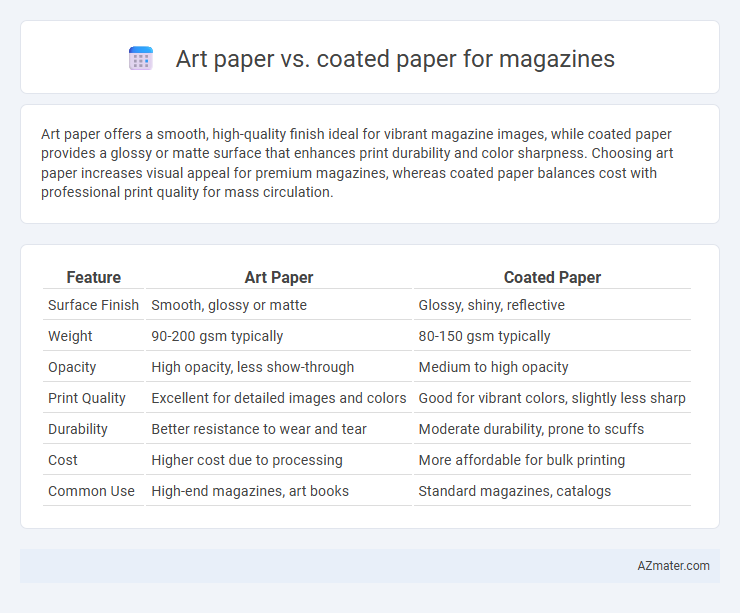Art paper offers a smooth, high-quality finish ideal for vibrant magazine images, while coated paper provides a glossy or matte surface that enhances print durability and color sharpness. Choosing art paper increases visual appeal for premium magazines, whereas coated paper balances cost with professional print quality for mass circulation.
Table of Comparison
| Feature | Art Paper | Coated Paper |
|---|---|---|
| Surface Finish | Smooth, glossy or matte | Glossy, shiny, reflective |
| Weight | 90-200 gsm typically | 80-150 gsm typically |
| Opacity | High opacity, less show-through | Medium to high opacity |
| Print Quality | Excellent for detailed images and colors | Good for vibrant colors, slightly less sharp |
| Durability | Better resistance to wear and tear | Moderate durability, prone to scuffs |
| Cost | Higher cost due to processing | More affordable for bulk printing |
| Common Use | High-end magazines, art books | Standard magazines, catalogs |
Understanding Art Paper and Coated Paper
Art paper, known for its smooth texture and high brightness, enhances image clarity and color vibrancy, making it ideal for high-quality magazine prints. Coated paper, featuring a surface layer of clay or other substances, provides a glossy or matte finish that improves ink holdout and sharpness, crucial for detailed photo reproduction. Both types balance print quality and cost, with art paper favoring finer image detail and coated paper offering versatile finish options for diverse magazine aesthetics.
Key Differences Between Art and Coated Paper
Art paper features a smooth, semi-gloss finish ideal for high-quality image reproduction, providing vibrant colors and sharp details in magazine printing. Coated paper has a glossy or matte finish but generally offers less brightness and color sharpness compared to art paper, making it more suitable for text-heavy magazines or those with moderate image quality requirements. Both types enhance print durability and reduce ink absorption, but art paper is preferred for premium magazines demanding superior visual impact.
Visual Quality: Which Paper Enhances Images Better?
Art paper offers superior image sharpness and vibrant color reproduction due to its smooth, non-glossy surface that minimizes glare and enhances detail. Coated paper, available in gloss or matte finishes, provides a reflective quality that intensifies color depth and contrast, making images appear more vivid and striking in magazines. For high-impact visual quality, coated paper generally enhances images better by delivering richer colors and a polished appearance, ideal for glossy magazine spreads.
Durability and Handling in Magazines
Art paper, known for its smooth texture and high weight, offers excellent durability and resistance to wear, making it ideal for magazines requiring long-lasting pages and vivid image reproduction. Coated paper, often featuring a glossy or matte finish, enhances print quality but can be more prone to scratching and fingerprint marks, affecting handling over time. Selection between art paper and coated paper for magazines depends on balancing durability needs with desired visual appeal and reader interaction.
Printing Techniques Suited for Each Paper Type
Art paper excels in offset printing due to its smooth, porous surface that absorbs ink well, resulting in sharp images and vibrant colors ideal for magazines with detailed graphics. Coated paper, especially gloss or satin finishes, suits digital and gravure printing techniques by providing a non-porous surface that enhances ink holdout and color consistency, perfect for magazines emphasizing high-gloss photos and vivid visuals. Choosing the printing method aligned with the specific paper type optimizes image quality, ink absorption, and overall magazine aesthetics.
Cost Considerations: Art Paper vs. Coated Paper
Art paper generally costs less than coated paper, making it a budget-friendly option for magazine printing. Coated paper involves higher production expenses due to specialized coatings that enhance print quality and durability. Choosing between art and coated paper depends on balancing cost constraints with desired visual impact and longevity.
Environmental Impact and Sustainability
Art paper and coated paper significantly differ in environmental impact and sustainability; art paper typically has a higher recycled fiber content and is often biodegradable, making it more eco-friendly for magazine printing. Coated paper involves chemical treatments and plastic-based coatings that hinder recycling and biodegradability, increasing landfill waste and pollution concerns. Choosing sustainably sourced art paper certified by FSC or PEFC promotes responsible forestry and reduces the magazine's carbon footprint.
Reader Experience and Tactile Appeal
Art paper offers a smooth, matte finish that enhances image clarity and reduces glare, significantly improving reader comfort during prolonged magazine engagement. Coated paper, with its glossy or satin surface, intensifies color vibrancy and sharpness, creating a visually striking effect that captivates readers at first glance. The tactile appeal of art paper provides a sophisticated, soft touch, while coated paper delivers a sleek, polished feel, both influencing the overall sensory experience and perceived quality of the magazine.
Common Uses of Art and Coated Paper in Magazines
Art paper in magazines is commonly used for high-quality image reproduction and glossy finishes, making it ideal for vibrant photo spreads and advertisements. Coated paper, with its smooth surface and varying finishes such as matte or gloss, is frequently chosen for editorial content and text-heavy pages to enhance readability and durability. Both papers contribute to visual appeal, but art paper emphasizes image clarity while coated paper balances aesthetics with practical text presentation.
How to Choose the Right Paper for Your Magazine
Choosing the right paper for your magazine depends on its purpose and desired visual impact, with art paper providing a smooth, non-glossy finish ideal for detailed images and text clarity. Coated paper, offering a glossy or satin finish, enhances color vibrancy and sharpness, making it suitable for magazines with high-quality photographs and vibrant graphics. Consider factors such as budget, printing technique, and target audience preferences to select the paper that best supports your magazine's aesthetic and functional goals.

Infographic: Art paper vs Coated paper for Magazine
 azmater.com
azmater.com